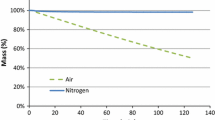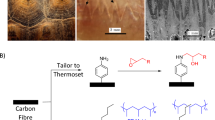Abstract
This paper has three principle thrusts: (i) the fabrication of unidirectionally reinforced composites made from carbon fibres subjected to different surface treatments in combination with various (polycarbonate, polyethersulphone and epoxy) matrices, (ii) a study of some of the mechanical properties (that is, the interlaminar-shear strength (ILSS) and the failure behaviour) of these composites; and (iii) determination of the correlations between the adhesion of the matrix polymers as measured by the ILSS and the surface structure as well as the surface chemistry of the various fibres. It will be shown that the surface structure of the fibres has a minor effect, while the surface chemistry appears to have an extraordinarily great influence on the adhesion of the fibres to high-temperature thermoplastics. The data clearly show that, depending on the processing temperature during the fabrication of the composites, chemical bonds can be formed at the fibre-polymer interface. This bond formation is initiated by the decomposition of carboxylic groups and, as a consequence, dangling carbon atoms are free to react with the functional groups of the polymer.
Similar content being viewed by others
References
P. J. Herrera-Franco and L. T. Drzal, Composites 23 (1992) 2–27.
A. Hampe in “Haftung bei verbundwerkstoffen and werkstoffverbunden” (DGM Informationsgesellschaft mbH, Oberursel, 1989) pp. 33–44.
F. P. Gerstle in “Encyclopedia of polymer science and engineering”, edited by H. F. Mark, N. M. Bikales, C. G. Overberger, G. Menges and J. I. Kroschwitz. Vol. 3, (Wiley, New York, 1988) pp. 776–820.
G. Krekel, K. J. Hüttinger, W. P. Hoffman and D. S. Silver, J. Mater. Sci. in press.
G. Krekel, K. J. Hüttinger and W. P. Hoffman, ibid. in press.
CIBA-GEIGY AG, Product information: Araldit LY556, Basel (1988).
S. W. Yurgatis and S. S. Sternstein, J. Mater. Sci. 23 (1988) 1861–1870.
G. Krekel, PhD thesis, University of Karlsruhe (1992).
K. J. Hüttinger, S. Höhmann-Wien and G. Krekel, Carbon 29 (1991) 1281–1286.
Idem. J. Adhesion Sci. Tech. 6 (1992), 317–331.
N. L. Allinger, M. P. Cava, D. C. De Jongh, C. R. Johnson, N. A. Lebel and C. L. Stevens, “Organische chemie” (de Gruyter, Berlin, 1980) pp. 825–830.
P. W. Atkins, “Physikalische chemie”, 1st Edn, Verlag Chemie, Weinheim (1987), 598–602; and Idem. Carbon 28 (1990) 221–228.
E. Fitzer and R. Weiss, Carbon 25 (1987) 455.
P. Ehrburger, J. J. Herque and J. B. Donnet, London, Soc. Chem. Ind 1 (1978) 398.
E. Fitzer, K. H. Geigl, W. Hüttner and R. Weiss, Carbon 18 (1980) 389–393.
J. Matsui, Crit. Rev. Surface Chem. 1 (1990) 71–130.
Author information
Authors and Affiliations
Rights and permissions
About this article
Cite this article
Krekel, G., Zielke, U.J., Hüttinger, K.J. et al. The relevance of the surface structure and surface chemistry of carbon fibres in their adhesion to high temperature thermoplastics. JOURNAL OF MATERIALS SCIENCE 29, 3984–3992 (1994). https://doi.org/10.1007/BF00355958
Received:
Accepted:
Published:
Issue Date:
DOI: https://doi.org/10.1007/BF00355958




